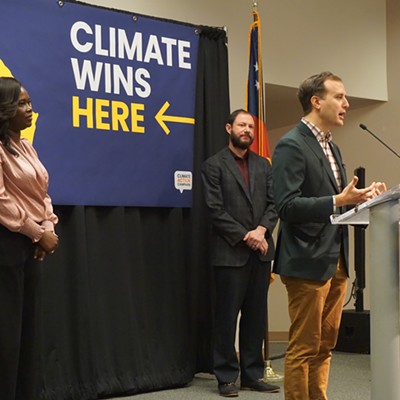With Georgia struggling with a rate of unemployment higher than the national average, you’d think a bipartisan bill that would create not just jobs, but whole new industries that would provide more jobs for decades, would sail through the legislature to great applause.
Instead SB401 languishes in committee and may never even get to a vote in the Senate, much less become law. (As I write this, the bill has also been attached to SB459 in another committee, so it may yet come to a vote.)
Sponsored by Sen. Buddy Carter (R–Pooler) and five other senators, the bill seeks to change provisions of “The Georgia Cogeneration and Distributed Generation Act of 2001.”
It would allow utility customers who generate power on their own property to finance the purchase of what is called a “distributed generation facility” by purchase, lease, loan, or other form of financing, including a power purchase agreement.
Further, the bill defines such a facility as one that uses a solar photovoltaic system, fuel cell, generators fueled by biomass, municipal solid waste, landfill gas, hydropower, or wind turbine.
The bill specifies that the facility be intended primarily to offset part or all of the customer requirements for electricity.
So why is this such a big deal, and why are Georgia Power and its allies doing a full court press to see that it never sees the light of day?
The relatively high upfront costs of a solar installation, or any other of the other facilities (including fuel cells), present a major barrier. Even with the 30 percent federal tax credit and the 35 percent state tax credit, the buyer has to come up with the whole system cost at one time.
Regional banks have yet to discover renewable energy loans. Local homebuilders aren’t providing solar systems as part of the mortgage (in which case the energy savings offset the slight increase in mortgage payments).
For reasons that escape me, owners of commercial buildings, also eligible for tax credits, plus accelerated depreciation, have yet to go solar or integrate fuel cells. Churches and non–profits that own their own buildings are not eligible for tax credits, so they are priced out of the market.
Except for Savannah Tech and a few panels on a SCAD building, local colleges and universities, as well as the entire school system, are devoid of solar.
But all that could change. Waiting for their cue to come onboard, major investors are ready to take advantage of power purchase agreements — if they can ever be covered under SB401/SB459.
Power purchase agreements work like this: Company A comes to a property owner and offers, in effect, to rent part of a building rooftop for many years (typically 20).
In exchange, Company A provides everything, including on–going maintenance, and sells the electricity to the property owner at a lower rate than that charged by the utility. Investors in Company A get the tax credits and the depreciation as well as an ongoing revenue stream.
It’s a win–win for everyone, except Georgia Power. At least that is what the utility claims. Citing a 40–year old law that gives Georgia Power monopoly territorial generation rights, they say Company A is acting like a utility.
Georgia Power doesn’t want the competition.
Georgia Power also frets about the problems of intermittent generation of electricity by solar and wind. It’s true. The wind dies down; clouds dancing across the skies cause a temporary shadow on solar modules and an abrupt drop in electricity.
Georgia Power claims that the company may have to invest in equipment to handle the interruption, and that means higher rates for everyone—at least that’s the claim.
But load balancing is something utilities do all the time. By chance, I had just renewed my subscription to “Transmission and Distribution World” when I heard about SB401.
It’s one of many trade magazines that present case histories and best practices. I’m sure utility engineers read it.
Georgia Power is already moving to a Smart Grid — that’s why the new smart meters — that will be even more adaptable to distributed energy generation.
Georgia Power, as Buddy Carter notes, is going to have to deal with intermittent generation anyway from systems financed by the owners, banks, etc. Whether they are financed privately or though a power purchase agreement is immaterial.
Fuel cells produce power though a chemical process in a cell where hydrogen and oxygen interact resulting in the highly efficient production of electricity and heat. Typically natural gas or biogas is the feedstock for the hydrogen.
Unlike solar and wind, electricity production is constant and predictable. Fuel cell prices are also coming down and could represent a major growth industry for the state.
Property owners, not Georgia Power, however, are making the major capital investment. And the availability of renewable sources of electricity will help the utility during times of peak demand when it has to pay more for backup power. That’s a win.
As Georgia becomes friendlier to renewable energy production — as the local market begins to grow — companies in all of the industries covered in SB401/SB459 will be attracted to the state.
New business means new customers for the electric utilities — another win.
For more info go to:
solarcitiesusa.com/green-jobs.pdf
solarchampions.wordpress.com























